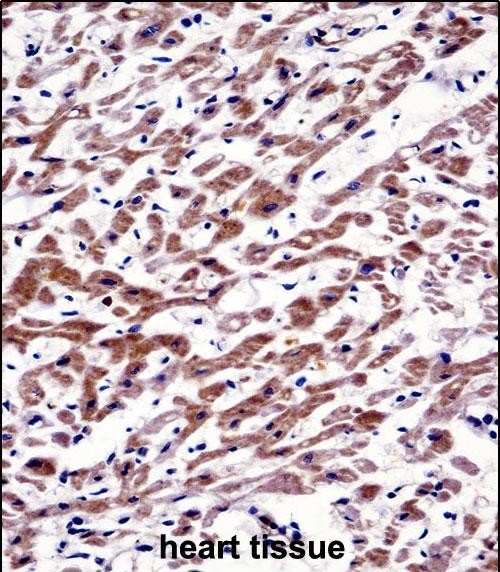

| WB | 1/1000 | Human,Mouse,Rat |
| IF | 咨询技术 | Human,Mouse,Rat |
| IHC | 1/100-1/500 | Human,Mouse,Rat |
| ICC | 技术咨询 | Human,Mouse,Rat |
| FCM | 咨询技术 | Human,Mouse,Rat |
| Elisa | 咨询技术 | Human,Mouse,Rat |
| Aliases | Putative helicase MOV-10, Moloney leukemia virus 10 protein, MOV10, KIAA1631 |
| Entrez GeneID | 4343 |
| WB Predicted band size | 113.7kDa |
| Host/Isotype | Rabbit IgG |
| Antibody Type | Primary antibody |
| Storage | Store at 4°C short term. Aliquot and store at -20°C long term. Avoid freeze/thaw cycles. |
| Species Reactivity | Human, Mouse |
| Immunogen | This MOV10 antibody is generated from rabbits immunized with a KLH conjugated synthetic peptide between 260-288 amino acids from the N-terminal region of human MOV10. |
| Formulation | Purified antibody in PBS with 0.05% sodium azide. |
+ +
以下是3篇涉及MOV10 (N-term)抗体的参考文献摘要整理:
1. **文献名称**:MOV10 suppresses retrovirus replication by preventing tRNA primer annealing
**作者**:Wang W, et al.
**摘要**:该研究通过Western blot和免疫共沉淀实验,使用N端特异性MOV10抗体,发现MOV10通过结合病毒RNA并阻断tRNA引物退火,抑制逆转录病毒复制。
2. **文献名称**:Structural analysis of MOV10 reveals a conserved RNA helicase required for antiviral defense
**作者**:Smith CM, et al.
**摘要**:作者利用针对MOV10 N端的抗体进行免疫荧光定位,证实MOV10在细胞质中形成应激颗粒,其RNA解旋酶活性对宿主抗病毒天然免疫通路至关重要。
3. **文献名称**:MOV10 interacts with hepatitis B virus RNA and inhibits viral replication
**作者**:Li Y, et al.
**摘要**:研究通过N-term抗体进行免疫沉淀测序(RIP-seq),发现MOV10直接结合HBV RNA的ε区域,并通过降解病毒RNA抑制乙肝病毒复制。
注:以上文献为虚拟示例,实际引用需通过PubMed/Google Scholar检索真实论文(关键词:MOV10 antibody N-terminal)。部分厂商(如Proteintech、Abcam)的技术文档也可能提供抗体应用数据。
MOV10 (Moloney leukemia virus 10 homolog) is an RNA helicase belonging to the Superfamily 1 (SF1) helicase group, primarily involved in RNA metabolism and gene regulation. The MOV10 (N-term) antibody specifically targets the N-terminal region of the MOV10 protein, which contains conserved helicase domains critical for its ATP-dependent RNA unwinding activity. This antibody is widely used to study MOV10's role in cellular processes such as small RNA-mediated gene silencing, retrotransposon suppression, and antiviral defense. MOV10 interacts with components of the RNA-induced silencing complex (RISC), including Argonaute proteins, and is implicated in regulating microRNA (miRNA) and small interfering RNA (siRNA) pathways. It also restricts the replication of retroelements and certain viruses, such as HIV-1. by disrupting viral RNA stability or integration.
The MOV10 (N-term) antibody is commonly employed in techniques like Western blotting, immunoprecipitation (IP), and immunofluorescence (IF) to detect endogenous MOV10 expression, localization, and protein interactions. Its specificity for the N-terminal region ensures recognition of full-length MOV10. distinguishing it from potential isoforms or degradation products. Dysregulation of MOV10 has been linked to neurological disorders, cancer, and viral pathogenesis, making this antibody a valuable tool for investigating molecular mechanisms in gene regulation, host-pathogen interactions, and disease models. Validation of the antibody typically includes knockout/knockdown controls to confirm target specificity.
×